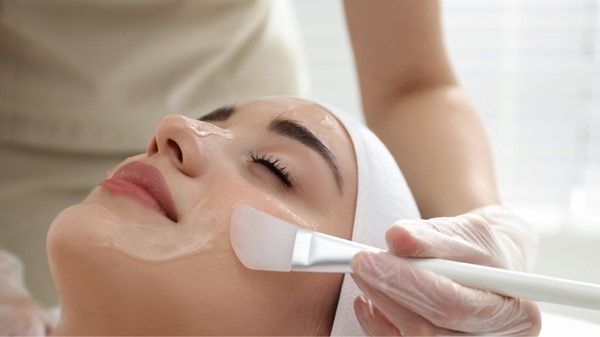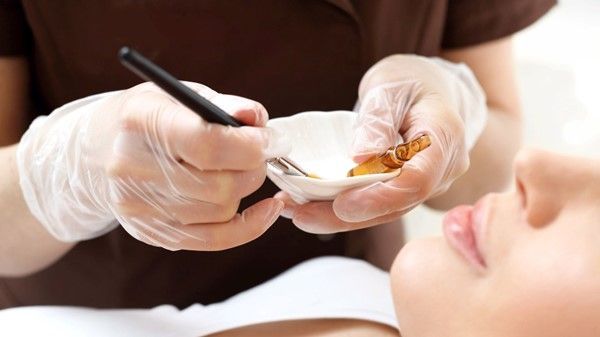The Benefits of a Skin Peel Facial for a Brighter, Smoother Skin Tone
A skin peel facial, or chemical peel, is a popular treatment that rejuvenates the skin by applying a chemical solution that exfoliates and removes the outer layers. This results in a brighter, smoother complexion with fewer wrinkles and more even pigmentation. Skin peels can also help with concerns like acne scars, sun damage, and age spots by stimulating collagen production and increasing cell turnover, making it an ideal option for revitalizing skin.
Understanding the Process of a Skin Peel Facial and How It Works

Types of Chemical Peels
Chemical peels can be categorized into three main types based on their depth of penetration: superficial, medium, and deep chemical peels. Superficial peels, also known as light chemical peels, utilize mild acids like glycolic acid or lactic acid to gently exfoliate the outermost layer of skin. They are suitable for addressing uneven skin tone and rough skin texture with minimal downtime. Medium chemical peels usually contain trichloroacetic acid (TCA) and penetrate deeper into the skin to target issues such as age spots and fine lines. Deep chemical peels use stronger acids and are highly effective for severe skin conditions, providing profound rejuvenation but requiring longer recovery periods.
The Role of Acids in Chemical Peels
Various acids play specific roles in the chemical peeling process. Salicylic acid chemical peels are effective for treating acne and uneven skin tone, as salicylic acid is known for its ability to penetrate oily skin and clear clogged pores. Glycolic acid is a common alpha hydroxy acid (AHA) used in superficial peels to gently exfoliate and improve skin texture. Lactic acid offers hydration along with mild exfoliation, making it ideal for sensitive skin types. Meanwhile, trichloroacetic acid is frequently used in medium peels to address deeper wrinkles and hyperpigmentation.
Preparing for a Chemical Peel
Understanding one's skin type and concerns is crucial before undergoing a chemical peel. Proper preparation involves consultation with a skincare professional to select the appropriate peel and strength. It may also require pre-peel skincare regimens to maximize results and minimize potential side effects. Protecting the skin from sun exposure and avoiding harsh skincare products are essential steps in the days leading up to the treatment.
By exploring these aspects of chemical peels, individuals can make informed decisions on the best approach for achieving their desired skin improvements.
How Chemical Peels Improve Skin Texture and Reduce Signs of Aging

The Science Behind Skin Rejuvenation
Chemical peels are an effective method within cosmetic surgical procedures aimed at enhancing skin appearance by revealing youthful skin. When a chemical solution is applied, it causes exfoliation and eventually allows the skin's surface to peel away. This removal of the damaged outer layers encourages the growth of new skin which is smoother and less wrinkled. Consequently, this process not only improves skin texture but also reduces the visibility of fine lines and wrinkles, granting a more youthful glow.
Addressing Acne Scarring and Deep Scars
Chemical solutions used in both medium-depth peels and deep peels help in smoothing out acne scarring and other deep scars. Trichloroacetic acid and carbolic acid are often used in deeper peels to penetrate skin layers, promoting deeper exfoliation and facilitating improved collagen production. As the skin heals, these acids help in the reduction of scar tissue, leading to a more even-toned complexion.
The Importance of Skin Type and Professional Guidance
A comprehensive understanding of one's skin type is critical when considering chemical peels. Consulting a dermatologic surgeon ensures choosing the suitable type of peel, whether it’s a medium peel or a deeper option, tailored to address individual skin concerns. It is crucial to prepare the skin properly before and after the treatment, particularly to avoid cold sores and minimize side effects. Proper post-treatment care involves avoiding direct sun exposure to protect the new, sensitive skin, enhancing recovery, and ensuring lasting results.
Temporary or Permanent Change and Continued Care
Chemical peels can lead to a temporary or permanent change in skin appearance, depending on the depth of the peel. For persistent results and to maintain more youthful skin, ongoing skincare and protection from sun exposure are vital. This proactive approach helps uphold the benefits achieved through the chemical peeling process and extends the rejuvenated look of the skin for the long term.
The Role of Glycolic Acid in Achieving Brighter and Smoother Skin

Understanding Glycolic Acid in Chemical Peels
Glycolic acid is a popular choice in chemical peels due to its efficacy in promoting brighter and smoother skin. As an alpha hydroxy acid (AHA), it works by loosening the bonds between dead skin cells, facilitating gentle exfoliation. When applied during a light chemical peel, glycolic acid can significantly improve skin texture and tone with minimal downtime.
Benefits for Different Skin Issues
Glycolic acid is particularly effective for treating dark patches and brownish discoloration, caused by conditions like post-inflammatory hyperpigmentation. For individuals with darker skin, a light peel using glycolic acid can minimize risks associated with deep chemical peels, such as uneven pigmentation. It also helps in addressing moderate lines and actinic keratosis, offering a rejuvenated skin appearance.
Glycolic Acid Treatment Process
Treatments usually span over five to seven days before revealing noticeable results. This period involves the gradual peeling of the treated skin leading to a brighter complexion. During this phase, it is crucial to follow all recommended aftercare processes, including sun protection, to safeguard the delicate new skin. Users might experience a mild stinging sensation, which is a normal part of the exfoliation process.
Post-Treatment Care and Considerations
Upon receiving a glycolic acid chemical peel, it's essential to avoid excessive sun exposure and follow any prescribed skincare regimen from a professional, such as oral antibiotics if needed for infection prevention. It's also important to note that certain factors, like wearing makeup, should be approached cautiously during the healing period to prevent irritation of the treatment area.
The Importance of Professional Guidance
Consulting a skincare professional is key to optimizing results and minimizing potential side effects. Whether opting for a medium chemical peel or a light peel, they can prescribe medication if necessary and provide tailored advice, ensuring that glycolic acid treatments are both safe and effective.
Why Chemical Peels Are Effective for Treating Acne Scars and Sun Damage

How Chemical Peels Work on Acne Scars
Chemical peels offer a solution for those looking to diminish acne scars through the process of deep peeling. When applied, the peel solution leads to exfoliation and eventually peels off the affected skin layers. This removal enables new, healthy skin to surface, significantly reducing the appearance of scars. Individuals with a family history of acne may find these treatments particularly beneficial as part of their cosmetic procedures strategy.
Addressing Sun Damage with Chemical Peels
Sun damage, characterized by discoloration and uneven skin tone, can be effectively treated with chemical peels. The process helps to remove damaged outer layers, promoting cellular turnover and revealing brighter skin. As an outpatient procedure, patients can achieve these improvements without the need for extensive downtime traditionally associated with surgery center settings. Prior medical history should be discussed with a professional to customize the treatment for optimal results.
The Role of Professional Care in Treatment
Key to the success of chemical peels in treating acne scars and sun damage is the involvement of a qualified healthcare provider. Professional guidance ensures that factors like skin type, peel selection, and medical history are carefully considered to tailor the strength and type of peel used. Safety and efficacy are paramount, and the correct approach minimizes risks while maximizing rejuvenation benefits, accounting for each patient’s family history and past cosmetic procedures.
How a Skin Peel Facial Stimulates Collagen Production for Youthful Skin

Understanding Collagen and Its Importance
Collagen is a fundamental protein that provides structure and elasticity to the skin. As we age, collagen production decreases, resulting in thinner skin and the development of wrinkles. Stimulating collagen production is essential in maintaining skin's youthful appearance, which can be achieved through various methods, including chemical peels.
The Role of Chemical Peels in Collagen Stimulation
Chemical peels, especially deep chemical peels, work by applying a chemical solution to the skin, causing the outer layers to eventually peel away. This process not only resurfaces the skin but also stimulates collagen production. The body responds to the peeling as a form of controlled injury, triggering the natural healing response that includes the formation of new collagen fibers.
Types of Chemical Peels for Collagen Boost
Different types of peels, such as light chemical peels, medium chemical peels, and deep peels, can be utilized depending on skin types and desired outcomes. Light peels, containing agents like salicylic acid, are suitable for mild rough skin concerns, while medium and deep peels penetrate further, addressing more pronounced aging signs by promoting more substantial collagen synthesis.
Post-Peel Process and Collagen Formation
As the skin heals from the chemical peeling, collagen fibers are regenerated, leading to smoother and firmer skin. The rejuvenated new skin benefits from the increased collagen, resulting in a more resilient and youthful appearance. Adequate post-treatment care, including protection against sun exposure and adherence to medical advice, enhances this effect.
Professional Guidance in Cosmetic Surgical Procedures
Seeking professional advice before undertaking any skin facial peel is crucial, particularly when involving deeper peels. Professional consultation ensures that the correct type of peel is chosen based on individual needs and medical history, maximizing benefits and minimizing risks. Tailoring the treatment to specific skin types and concerns assures safe and effective stimulation of collagen for youthful skin renewal.
Different Types of Chemical Peels and Their Benefits for Various Skin Concerns

Chemical peels come in several types, each designed to target specific skin concerns through the use of different chemical solutions. Understanding these variations is key to selecting the most appropriate treatment for individual needs.
Light Chemical Peel
Light chemical peels are ideal for addressing minor skin imperfections, such as slight roughness or uneven skin tones. Utilizing agents like salicylic acid, these peels gently exfoliate the skin, making them suitable for regular maintenance and those with sensitive skin. The benefits include improved skin clarity and a brighter complexion with minimal downtime.
Medium Chemical Peel
For more pronounced concerns, such as moderate sun damage or age spots, a medium chemical peel offers deeper exfoliation. This type of peel penetrates further into the skin layers, removing damaged cells and promoting regeneration. The procedure can significantly improve the appearance of fine lines and uneven pigmentation while maintaining a relatively short recovery period.
Deep Chemical Peel
The deep chemical peel is reserved for targeting severe skin issues, including deep wrinkles, pronounced scars, and significant texture irregularities. This procedure involves a stronger chemical solution, allowing penetration into the deeper layers of the skin. Although it requires a longer recovery time, the results are dramatic, offering substantial skin rejuvenation and a notable reduction in advanced signs of aging.
Choosing the Right Chemical Peel
Selecting the appropriate peel involves a careful assessment of skin type, concerns, and desired outcomes. A professional evaluation helps determine which peel—light, medium, or deep—is best suited to individual skin concerns. Working with a skincare expert ensures a safe and effective tailored treatment, optimizing the benefits of each peel type for a refreshed and revitalized appearance.
The Impact of a Deep Peel on Reducing Wrinkles and Fine Lines
Understanding the Mechanism of a Deep Peel
A deep peel penetrates the most extensive layers of the skin, making it the most intensive type of chemical peel. It utilizes potent acids, such as phenol, to reach deeper skin levels. This thorough exfoliation process removes the outermost layers of damaged skin, prompting the skin's natural healing process and encouraging new cell growth. As the skin rebuilds, it results in a smoother, more even surface.
Efficacy in Reducing Wrinkles and Fine Lines
Deep peels are highly effective in diminishing the appearance of fine lines and wrinkles. By removing the damaged surface layers, fresh, new skin is revealed, leading to a reduction in the visibility of these aging signs. The peel stimulates significant collagen production, providing the additional benefit of enhancing skin elasticity and resilience. This rejuvenation process leads to smoother skin texture and a more youthful appearance.
Long-term Benefits and Considerations
While the immediate results of a deep peel are impressive, the long-term benefits also include sustained improvements in skin texture and tone. However, this procedure requires careful consideration, as it involves a lengthy recovery period with specific post-procedural care to maximize results and minimize complications. Consulting with a qualified dermatologist or skincare professional ensures proper evaluation of skin health and suitability for a deep peel.
Precautions and Aftercare
Following a deep peel, the skin is particularly sensitive. It is vital to adhere to recommended aftercare practices, such as avoiding sun exposure, moisturizing regularly, and following any prescribed skincare regimen. Professional guidance during the recovery phase ensures optimal healing and the realization of the full benefits of the procedure.
How Chemical Peels Improve Skin Texture and Reduce Signs of Aging
Mechanism of Action
Chemical peels lighten hyperpigmentation by using specific acids, such as glycolic or lactic acid, that penetrate the upper layers of the skin. These acids work by breaking down the bonds between dead skin cells, causing them to shed and reveal fresher skin underneath. This exfoliation process accelerates cell turnover, gradually diminishing dark spots and evening out skin tone.
Types of Chemical Peels for Pigmentation
Different types of peels can be tailored to address pigmentation issues depending on the severity of the concern. For mild pigmentation, a light peel may suffice; however, more stubborn pigmentation can require medium or deep chemical peels, which reach deeper layers of the skin. A consultation with a skincare professional is crucial for determining the appropriate type of peel based on individual skin concerns.
Benefits of Regular Treatment
Regular chemical peel treatments can maintain an even skin tone and help reduce the recurrence of pigmentation. By consistently encouraging new cell growth and eliminating surface pigment accumulation, ongoing sessions keep the complexion smooth, radiant, and blemish-free. This not only improves aesthetic appearance but also enhances skin texture and luminosity.
Considerations and Professional Advice
Before undergoing a chemical peel, it's essential to understand the potential risks and address any underlying skin conditions that may be contributing to pigmentation. Professional advice ensures the chosen peel is safe and effective, catering to specific skin types and concerns. Consistent aftercare, such as using sunscreen and hydrating the skin, supports optimal results and maintains balanced pigmentation.
Skin Peel Facials for Addressing Age Spots and Hyperpigmentation
The Role of Skin Peel Facials
Skin peel facials are an effective method of targeting age spots and hyperpigmentation by removing the damaged outer layers of skin and promoting natural cell renewal. These facials often incorporate a blend of chemical exfoliants designed to penetrate varying depths of the skin. By choosing the appropriate formulation, these treatments can help diminish discoloration and even out skin tone.
How Skin Peel Facials Work
The procedure involves applying a chemical solution that causes the top layers of skin to peel off, revealing newer, clearer skin beneath. Ingredients commonly used in skin peel facials include alpha hydroxy acids (AHAs), beta hydroxy acids (BHAs), and retinoids, all renowned for their ability to break down pigmented cells and accelerate skin turnover. This process not only reduces the appearance of age spots but also refines skin texture and clarity.
Selecting the Right Facial for Your Needs
Choosing the right skin peel facial depends on the depth and severity of pigmentation issues. Light peels can address superficial spots and deliver gentle exfoliation, while medium peels offer more intensive treatment for stubborn pigmentation. Consulting with a skincare specialist enables a personalized approach, ensuring the selected facial aligns with individual skin goals while minimizing risks.
Benefits and Expectations
Consistent use of skin peel facials can lead to significant improvements in pigmentation and overall skin tone. With regular treatments, the skin retains a luminous and youthful appearance, as renewed cells replace damaged ones. Although visible results often require multiple sessions, each facial contributes to long-term skin health and reduction of age-related discoloration.
Post-Facial Care and Maintenance
After a skin peel facial , proper aftercare is essential to safeguard the newly revealed skin. This includes avoiding direct sun exposure, applying broad-spectrum sunscreen diligently, and maintaining a hydrating skincare routine to ensure optimal recovery and prolong the benefits of the treatment. Professional aftercare advice not only supports healing but also enhances the overall effectiveness of the facial.
Contact Bel Viso Medical Spa for Personalized Skincare Solutions
Are you ready to transform your skin and achieve a radiant, even complexion? Reach out to Bel Viso Medical Spa today for a complimentary consultation with our skincare experts. Our team is dedicated to tailoring treatments specifically to your individual needs, ensuring effective and safe outcomes. Whether you're interested in chemical peels, skin peel facials, or other rejuvenating therapies, Bel Viso Medical Spa is here to help you on your journey to healthier, glowing skin. Contact us now to schedule your appointment and take the first step towards a more confident you!





